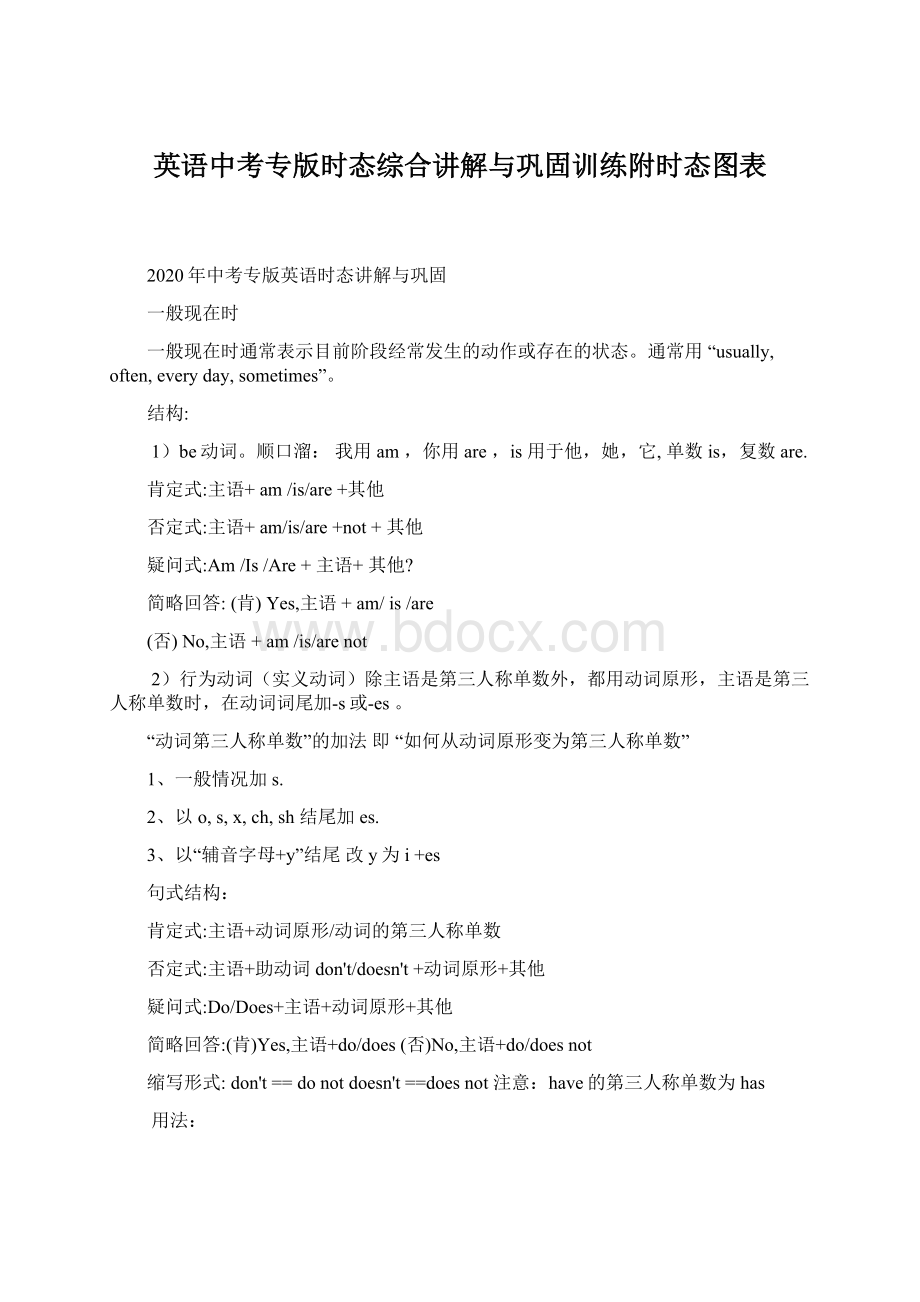英语中考专版时态综合讲解与巩固训练附时态图表.docx
《英语中考专版时态综合讲解与巩固训练附时态图表.docx》由会员分享,可在线阅读,更多相关《英语中考专版时态综合讲解与巩固训练附时态图表.docx(20页珍藏版)》请在冰豆网上搜索。

英语中考专版时态综合讲解与巩固训练附时态图表
2020年中考专版英语时态讲解与巩固
一般现在时
一般现在时通常表示目前阶段经常发生的动作或存在的状态。
通常用“usually,often,everyday,sometimes”。
结构:
1)be动词。
顺口溜:
我用am,你用are,is用于他,她,它,单数is,复数are.
肯定式:
主语+am/is/are+其他
否定式:
主语+am/is/are+not+其他
疑问式:
Am/Is/Are+主语+其他?
简略回答:
(肯)Yes,主语+am/is/are
(否)No,主语+am/is/arenot
2)行为动词(实义动词)除主语是第三人称单数外,都用动词原形,主语是第三人称单数时,在动词词尾加-s或-es。
“动词第三人称单数”的加法即“如何从动词原形变为第三人称单数”
1、一般情况加s.
2、以o,s,x,ch,sh结尾加es.
3、以“辅音字母+y”结尾改y为i+es
句式结构:
肯定式:
主语+动词原形/动词的第三人称单数
否定式:
主语+助动词don't/doesn't+动词原形+其他
疑问式:
Do/Does+主语+动词原形+其他
简略回答:
(肯)Yes,主语+do/does(否)No,主语+do/doesnot
缩写形式:
don't==donotdoesn't==doesnot注意:
have的第三人称单数为has
用法:
1.表示事实,现状,性质或经常的,习惯的动作,常与often,usually,always,sometimes,today,everyday,onceaweek,everyfiveminutes,onSundays等时间状语连用,eg.Hehasabrother.
2.表示普遍真理.eg.Theearthgoesroundthesun.
3.表示在现在时间里所发生的一个动作.eg.Herecomesthetrain.
4.在时间和条件状语从句中代表一般将来时.eg.I'llgowithyouifyouarefreetomorrow.
一般现在时用法专练:
一、用括号内动词的适当形式填空。
1.Heoften________(have)dinnerathome.
2.DanielandTommy_______(be)inClassOne.
3.We_______(notwatch)TVonMonday.
4.Nick_______(notgo)tothezooonSunday.
5.______they________(like)theWorldCup?
二、改错(划出错误的地方,将正确的写在横线上)
1.IsyourbrotherspeakEnglish?
__________________
2.Doeshelikesgoingfishing?
__________________
3.Helikesplaygamesafterclass.__________________
4.Mr.WuteachsusEnglish.__________________
5.Shedon’tdoherhomeworkonSundays._________________
一般过去时
一般过去时通常用“amomentago,justnow,yesterday,last…”等。
1.一般过去时表示过去某个时间发生的动作或存在的状态,常和表示过去的时间状语连用。
一般过去时也表示过去经常或反复发生的动作感谢。
2.Be动词在一般过去时中的变化:
⑴am和is在一般过去时中变为was。
(wasnot=wasn’t)
⑵are在一般过去时中变为were。
(werenot=weren’t)
⑶带有was或were的句子,其否定、疑问的变化和is,am,are一样,即否定句在was或were后加not,一般疑问句把was或were调到句首。
3.行为动词的一般过去时变化
肯定句(Positive)
动词过去式
Iwentshoppinglastnight.
否定句(Negative)
didn’t+动词原形
Ididn’tgoshoppinglastnight.
一般疑问句(Yes/No)
Did…+动词原形…?
Didyougoshoppinglastnight?
特殊疑问句(wh-)
Whatdid…+动词原形…?
Whatdidyoudolastnight?
4.动词过去式的变化:
规则动词的变化:
一般动词
+ed
planted,watered,climbed
以不发音的e结尾
+d
liked
辅音字母加y结尾
-y+ied
study—studied,cry-cried
重读闭音节单词,末尾只有一个辅音字母
双写最后一个字母+ed
stop–stopped
plan-planned
不规则动词的变化:
原形
过去式
原形
过去式
原形
过去式
原形
过去式
sweep
swept
teach
taught
have
had
go
went
keep
kept
think
thought
do
did
find
found
sleep
slept
buy
bought
eat
ate
say
said
feel
felt
drink
drank
is/am
was
take
took
read
read
give
gave
are
were
mean
meant
put
put
sing
sang
drive
drove
meet
met
cut
cut
begin
began
speak
spoke
make
made
let
let
ring
rang
write
wrote
see
saw
fly
flew
run
ran
ride
rode
come
came
draw
drew
sit
sat
hear
heard
tell
told
grow
grew
learn
learned/learnt
get
got
know
knew
5.特殊疑问句:
⑴疑问词+did+主语+动词原形?
如:
WhatdidJimdoyesterday?
⑵疑问词当主语时:
疑问词+动词过去式?
如:
Whowenttohomeyesterday?
一般过去时练习:
一、用be动词的适当形式填空
1.I_______atschooljustnow.2.He________atthecamplastweek.
3.We___studentstwoyearsago.4.They_____onthefarmamomentago.
5.YangLing________elevenyearsoldlastyear.
6.It______Ben’sbirthdaylastFriday.
二、用行为动词的适当形式填空
1.He_________(live)inWuxitwoyearsago.
2.Thecat________(eat)abirdlastnight.
3.We_______(have)apartylastHalloween.
4.Nancy________(pick)uporangesonthefarmlastweek.
5.I________(make)amodelshipwithMikeyesterday.
6.He_______footballnow,butthey_______basketballjustnow.(play)
7._______they________(sweep)theflooronSunday?
No,they_____.
一般将来时
概念:
表示将要发生的动作或存在的状态及打算、计划或准备做某事。
句中一般有以下时间状语:
tomorrow,nextday(week,month,year…),soon,thedayaftertomorrow(后天)等。
1.基本结构:
①主语+be(is,am,are)goingto+动词原形.
②主语+will+动词原形.
2.否定句:
①主语+be(is,am,are)+not+goingto+动词原形.
②主语+will+not(won’t)+动词原形.
例如:
I’mgoingtohaveapicnicthisafternoon.→
I’mnotgoingtohaveapicnicthisafternoon.
3.一般疑问句:
①Is(Are)+主语+goingto+动词原形.+?
②Will+主语+动词原形+?
例:
Wearegoingtogoonanoutingthisweekend.
→Areyougoingtogoonanoutingthisweekend?
Yes,weare.No,wearen’t.
WillhegotoBeijingnextweek?
Yes,hewill.No,hewon’t.
4.对划线部分提问。
一般情况,一般将来时的对划线部分有三种情况。
1).问人。
Who例如:
I’mgoingtoNewYorksoon.→Who’sgoingtoNewYorksoon.
2).问干什么。
What…do.例如:
Myfatherisgoingtowatcharacewithmethisafternoon.→Whatisyourfathergoingtodowithyouthisafternoon.
3).问什么时候。
When.例如:
She’sgoingtogotobedatnine.→Whenisshegoingtobed?
5同义句:
begoingto=willIamgoingtogoswimmingtomorrow(明天).=Iwillgoswimmingtomorrow.
一、练习:
填空
1.我打算明天和朋友去野炊。
I_____________________haveapicnicwithmyfriends.I________haveapicnicwithmyfriends.
2.下个星期一你打算去干嘛?
我想去打篮球。
What___________________________________________nextMonday?
I__________________playbasketball.What_________youdonextMonday?
I________playbasketball.
3.你妈妈这个周末去购物吗?
是,她要去买一些水果。
_____yourmother_______________goshoppingthis___________?
Yes,she_________.She________________________buysomefruit.
4.你们打算什么时候见面。
Whattime_______you___________________meet?
现在进行时
通常用“now/look/listen”.
1.现在进行时表示现在正在进行或发生的动作,也可表示当前一段时间内的活动或现阶段正在进行的动作。
2.现在进行时的结构:
.
肯定句:
主语+be(is,am,are)+动词现在分词-ing
eg:
Iam(not)doingmyhomework.You/We/Theyare(not)reading.
否定句:
主语+be(is,am,are)+not+动词现在分词-ing
一般疑问句:
Is(Are)+主语+动词现在分词-ing?
特殊疑问:
疑问词+be+主语+动词ing?
3.动词加ing的变化规则
1)一般情况下,直接加ing,如:
cook-cooking
2)以不发音的e结尾,去e加ing,如:
make-making,taste-tasting
3)如末尾是一个元音字母和一个辅音字母,双写末尾的辅音字母,再加ing,
如:
run-running,stop-stopping,swim—swimming
4. 现在进行时专项练习:
用所给的动词的正确形式填空:
1.Theboy__________________(draw)apicturenow.
2.Listen.Somegirls_______________(sing)intheclassroom.
3.Mymother_________________(cook)somenicefoodnow.
4.What_____you______(do)now?
5.Look.They_______________(have)anEnglishlesson.
6.______Helen____________(wash)clothes?
Yes,sheis.
过去进行时
句式结构:
肯定句:
主语+助动词be(was,were)+动词现在分词-ing+其它
否定句:
主语+助动词be(was,were)+not+动词现在分词-ing+其它
一般疑问句:
Was(Were)+主语+动词现在分词-ing+其它?
特殊疑问句:
疑问词+was(were)+动词现在分词-ing+其它?
用法:
1、表示在过去某一时间正在进行的动作,往往有表示过去的时间状语then,atthattime,thistimeyesterday等,或与过去发生的某事同时发生的动作(即与when,while引出的时间状语从句连用)。
例:
Theyweretalkingaboutafilmatsixyesterdayevening.昨晚6点他们正在谈论一部电影。
Whatwereyoudoingatthistimelastweek?
上周的这个时候你在干什么?
Whentheteachercamein,theyweretalking.老师进来时,他们在讲话。
2、表示在过去某一段时间内进行的动作。
例:
Theywereswimmingfromtwotothreeyesterdayafternoon.
ShewaswatchingTVthewholemorning.
3、表示过去将要发生的动作。
例:
HesaidhewasleavingonTuesday.他说他周二动身。
Tomsaidhewasgoingtomorrow.汤姆说他明天去。
过去进行时练习题:
一、动词填空。
1.John_______(work)alldayyesterday.
2.—What______you_______(do)atteno'clockyesterday﹖
—I_______(study)inclass.
3.WhenHarry_______(have)breakfastLily_______(telephone)him.
4.WhenI________(go)toschoolthismorningI______(see)acarrunningintoabus.
6.ThistimeyesterdayJack______(mend)hisbike.
7.I______(write)aletterattenlastnight.
8.Itwassix.TheGreens______(have)supper.
9.Whenyou_____(knock)atthedooryesterday,I______(do)somewashing.
10.Whilemymother______(watch)TV,I______(make)akite.
现在完成时
句式构成:
肯定句:
主语+助动词have(has)+动词过去分词-ed
否定句:
主语+助动词have(has)+not(haven’t,hasn’t)+动词过去分词-ed
一般疑问句:
Have(Has)+主语+动词过去分词-ed+?
特殊疑问句:
疑问词+have(has)+主语+动词过去分词-ed+?
用法:
1、表示说话之前已完成的动作,而且这个动作的结果对现在是情况仍有影响。
常被just,already,yet等副词修饰。
Mr.WanghasjustcomebackfromAmerica.王先生刚从美国回来。
2.现在完成时还可用来表示过去发生的动作一直延续到现在,常带有for或since等表示一段时间的状语。
如:
MrWanghaslivedheresince1983.
3.现在完成时瞬间动词即终止性动词不能与表示一段时间的状语连用。
常见终止性动词与延续性动词(或状态动词)的对应关系如下:
come/go/arrive/get/reach/move---bein/at
open---beopendie---bedead
close---beclosedbecome---be
borrow---keepputon---wear
buy---haveleave-----beaway(from)
begin/start-----beonfallasleep----beasleep
end/finish-----beovercatchacold-----haveacold
jointhearmy----beinthearmy,beasoldier
jointheParty----beintheParty,beaPartymember
例:
吉姆买这支已有两年了。
Jimboughtthispentwoyearsago.
Jimhashadthispenfortwoyears.
Jimhashadthispensincetwoyearsago.
Jimhashadthispensince2007
ItistwoyearssinceJimboughtthispen.
4.在表示“最近几世纪/年/月以来……”时间状语中,谓语动词用现在完成时。
inthepastfewyears/months/weeks/days;overthepastfewyears;duringthelastthreemonths;forthelastfewcenturies,throughcenturies;throughouthistory等
5.表示“第几次做某事,”或在“Itisthebest(worst,mostinteresting)+名词+that”后面跟现在完成时。
例:
ThisismyfirsttimethatIhavevisitedChina.
ThisisthemostinterestingfilmIhaveeverseen.
Thatistheonlybookthathehaswritten.
6.have/hasbeento+地点意为“曾去过某地”,暗含目前已不在该地,仅表示当事人的一种经历而已。
have/hasgoneto+地点“到了某地去了”,暗含“已离开原地去了某地”之意,但是否到达了某地尚不确定。
如:
HehasgonetoShanghai.他去了上海。
HehasbeentoShanghai.他去过了上海。
1、MissGreenisn'tintheoffice.she_______tothelibrary.
A.hasgoneB.wentC.willgoD.hasbeen
2、Myparents______Shandongfortenyears.
A.havebeeninB.havebeentoC.havegonetoD.havebeen
3、Thestudentshavecleanedtheclassroom,?
A.sotheyB.don’ttheyC.havetheyD.haven’tthey
4、Hisuncleformorethan9years.
A.hascomehereB.hasstartedtoworkC.haslivedthereD.haslefttheuniversity
时态分类练习
一般现在时与现在进行时专练
()1.Fatherusually______hisnewspaperafterdinner.
A.readB.readsC.readingD.isreading
()2.TheBlacksoften______tothecinemaonSaturdayevenings.
A.goB.goesC.isgoingD.aregoing
()3.Look!
Theboy______withhismotherinthepool.
A.isswimmingB.isswimmingC.areswimmingD.areswiming
()